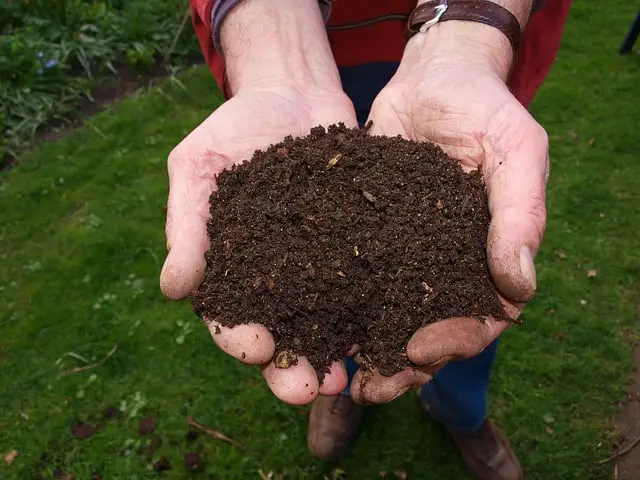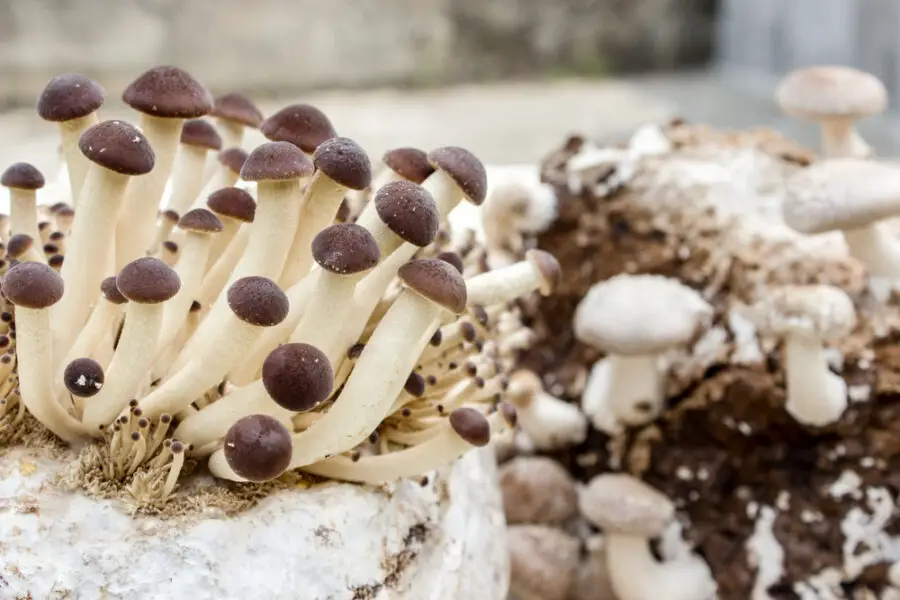Getting the right mushroom spawn that suits your purpose and establishing the correct growing conditions for it are essential for stimulating mushroom growth. You need to make sure the growing location is ideal for growing mushrooms, for which you need to control parameters like temperature, sunlight, moisture and humidity.
How Do Mushrooms Even Grow?
Mushrooms grow from spores, not seeds. These spores are highly microscopic; you cannot see them with the naked eye. Spores contain the blueprint needed to stimulate mushroom growth.
Mature mushrooms can contain up to 16 billion spores, which explains the rapid and sudden appearance of mushrooms in your lawns and gardens. For their nourishment, spores require a growing medium, which can be soil, wood chips, sawdust, grain, straw, or a mixture of compost with any of these.
Once mushroom spores meet a growing medium (known as the substrate), a white, thread-like substance called mycelium grows. The fruiting bodies that sprout from the mycelium are mushrooms.
Mushroom spawn is the combination of spores and growing medium, and has the mycelium already growing in it. It holds the mushroom mycelium strain in statis until it is transferred to the final habitat where the mycelium can grow and give mushrooms.
How Do I Select the Mushroom Spawn?
The biggest reason why people are unable to successfully grow mushrooms is because they chose the wrong kind of spawn for their intended use. You need to ask yourself some questions before purchasing the mushroom spawn.
Are you growing mushrooms commercially, or for your community, or even just for your home? Are you growing mushrooms inside or outside? How much space are you working with?
Now, with that out of the way, let’s have a look at three of the most common spawn types: grain, plug and sawdust.
Grain Spawn
Grain spawns are preferred for commercial indoor mushroom growing. They’re not ideal for growing on logs, but are an incredible option for inoculating shrooms on straw beds and wood chips in planting trays. They are richer in nitrogen due to them being a grain product, which provides some extra nutrition as well.
Conversely, this nitrogen-rich quality means other microbes and fungi readily attack grain spawns, which in turn leads to less mushroom growth. Sterilized or pasteurized growing habitats need to adopted for this type.
Plug Spawn
Plug spawns are used exclusively for growing mushrooms on logs. They’re easy and straightforward to use, and are easily accessible — you can find them at your local farmer’s market or garden centers.
Plug spawns are ideal for small to medium sized projects, and make for great gifts. However, they do take a longer time than other types of spawns to bear mushrooms.
Sawdust Spawn
Sawdust spawns are a lot similar to plug spawns: both are used exclusively for growing mushrooms on logs, except that sawdust spawns require an inoculation tool to insert the spawn into the drilled holes in the log. Once that’s done, the speed with which this type of spawn yields mushrooms makes them ideal for large, commercial uses.
Sawdust spawns are cheaper, more reliable and gives faster results. If you wish to grow mushrooms for many years to come, then this is the right type of spawn for you.
Where Should I Grow My Mushrooms?
Dark, humid and cool places encourage mushroom growth. Your basement is ideal for growing mushrooms, and in case you live in an apartment and don’t have access to a basement, a dark and damp spot under your sink is fine as well.
Nonetheless, some species of mushrooms still grow best outside on logs and prepared trays.
What Kind of Logs Should I Use for Growing Mushrooms?
You should only use healthy and newly-cut logs from spring before any leaves emerged on them. Three-foot-long logs that are 3 to 8 inches wide in diameter are the most appropriate for growing mushrooms. Oak wood logs are preferred for this use.
How Do I Grow Mushrooms in Planting Trays?
First off, get a suitable planting tray, and fill it with the growing medium (wood chips, compost, manure, hay, or a mixture of them) and leave an inch of space empty at the top. Then, spread your mushroom spawn all over. Make sure your hands and any other tools you’re using during this stage are sterilized to avoid contamination by other microbes and fungi.
And that’s it, really. Control the temperature, moisture and sunlight according to the requirement of the mushroom species you’re growing.
I Should Grow Mushrooms in Pitch Black, Right?
Mushrooms don’t require light to grow since they don’t contain chlorophyl, which all green plants have in order to photosynthesize for growth. That being said, a little light is needed by mushrooms for the fruiting bodies to grow. Growing mushrooms in absolute darkness might hamper their growth.
They don’t need to be in this dim light for a long time, a few hours each day is enough. Indirect or filtered sunlight, or even a fluorescent lamp, can provide this necessary light.
For outdoor growing, any shaded area that lets in filtered sunlight a few hours a day will do.
What Temperature Do I Need to Grow Mushrooms?
Most mushrooms grow best between 50 and 70 Fahrenheit. Make sure the place where you’re growing your mushrooms is away from direct heat, dry air and any drafts.
Outdoor logs can be kept under a proper shaded area, or under trees, to maintain the required temperature. Heating pads and soil thermometers are needed for mushrooms growing in trays.
How Do I Maintain the Moisture?
Water is necessary for mushroom growth, and since mushrooms have no skin, moisture is easily lost, which is why maintaining a damp environment is necessary. Keep in mind that mushrooms exchange gases with the atmosphere, so it is possible to drown mushrooms by using too much water. The growing environment should be humid, not wet.
Some mushrooms get their required moisture from their growing medium (compost, manure). For mushrooms growing in logs, the bark should be dry and the inner surfaces of the log moist. Mushrooms growing in planting trays need to be sprayed once or twice a day, or be covered with damp towels.


